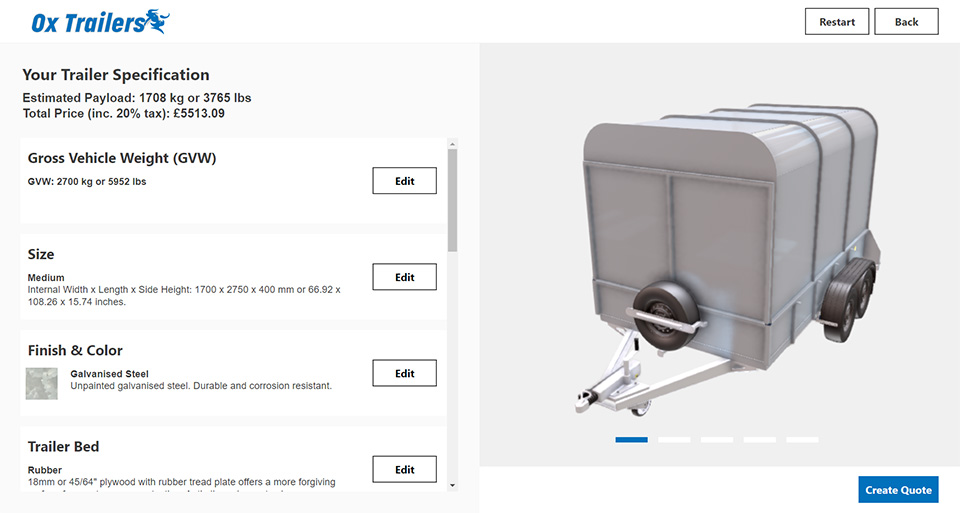Estimated reading time: 4 minutes
Guided selling for complex configurable products
This article explains the challenges of selling complex configurable products and looks at some of the tools and technologies you can use to overcome them.
Challenges of selling complex configurable products
Selling complex products is challenging. Complex products typically have a vast range of interlinked configuration options that make it difficult for salespeople to confidently configure products, calculate pricing and discounts, and produce quotations and sales documents.
The challenges don’t stop with sales either. They extend to the engineering teams that must produce custom manufacturing data, often for speculative orders. This can be a bottleneck in the sales process and uses valuable engineering capacity.
The solution? Configure, Price, Quote (CPQ) for Manufacturing software.
CPQ for Manufacturing software enables companies selling complex configurable products to configure, price and quote custom products easily, and automatically creates the documents and data required by sales and manufacturing.
What is CPQ and guided selling?
It’s difficult for salespeople to build and maintain the depth of product knowledge required to configure complex custom products accurately. And that doesn’t take into consideration the need to identify upsell opportunities, calculate pricing information and handle questions about the product, all whilst delivering exceptional customer experience.
Guided selling empowers salespeople to confidently configure complex products, even when they don’t have extensive product knowledge. It removes the need for salespeople to know every detail about a product and how it can be configured, so they can focus on helping customers.

Entering product requirements
Product specifications are entered into custom forms.
As product options are selected, guided selling systems update to only allow valid configuration choices. If a product option isn’t valid, CPQ tools with guided selling features can provide information about compatibility issues and make suggestions for suitable alternatives. They can even be configured to identify and suggest valid upsell and cross-sell opportunities, supporting salespeople to meet business goals.
Even if a salesperson has built the required technical understanding of the product, communicating the options and specifications to the customer can be a new challenge. Guided selling tools often have features like images and 3D visualizations that help customers to understand product details and make informed configuration decisions. This not only improves the user experience but also reduces the likelihood of changes being made later on due to misunderstandings.
Calculating the price of complex custom products as they are configured is tough. For many companies, it’s just too difficult and they are forced to calculate pricing as a separate stage in the sales cycle. The pricing stage can be time-consuming, salespeople will often need to reference different spreadsheets and consult with the engineering team before they can send anything over to the customer.
CPQ applications answer these challenges with powerful tools that allow salespeople to calculate pricing for every configuration, and even consider increased manufacturing complexity for specific configuration choices.
Real-time pricing enables customers to balance their requirements and budget as they configure, instead of requesting changes and waiting for updates. Centralizing pricing and discount information also ensures that key accounts receive consistent pricing regardless of the salesperson.
Preparing quotes and sales documentation for complex configurable products is often time-consuming. Salespeople are tied up creating documents when their time could be better focused on helping customers and progressing sales. Automating the preparation of sales documentation removes the burden on sales teams and allows them to respond to inquiries quickly.
Sales momentum is maintained too as customers are provided with all the information they need to move forward with a decision, without having to wait for it to be manually prepared. The ability to respond quickly also puts your organization first, helping you to win more orders.
How do guided selling tools work?
Guided selling tools centralize the decisions, information, and experience your team uses to configure products. Typically this information is captured using a mixture of logical expressions, calculations, legislation, databases, business logic, and product requirements.
This information can then be used by the application to calculate values, make decisions, perform actions, and automatically create sales documents and manufacturing data.
Most applications will also integrate with other company systems such as ERP, CRM, MRP, PDM, CAM, PLM, and cloud services. This ensures that data across the company is shared and always up to date.
Examples of guided selling
Explore example configurators built using DriveWorks software to see what you could achieve.